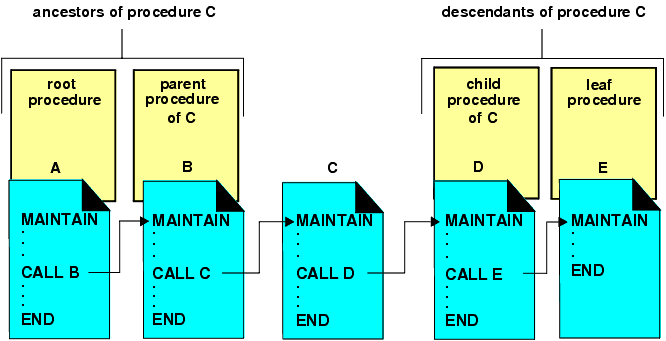All user variables (both stacks and simple, or scalar
variables) are global to a function or procedure, but not global
to the application. In other words, to protect them from unintended
changes in other parts of an application, you cannot directly reference
a variable outside of the procedure in which it is found (with the
exception of the FocError transaction variable). However, you can
access the variable data in other procedures, simply by passing it
as an argument from one procedure to another.
To pass variables as arguments, you only need to name them in
the CALL command, and then again in the corresponding MAINTAIN command,
using the FROM phrase for input arguments and INTO phrase for output
arguments. Some variable attributes must match in the CALL and MAINTAIN
commands:
- Number. The
number of arguments in the parent and child procedures must be identical.
- Sequence. The
order in which you name stacks and simple variables must be identical
in the CALL and corresponding MAINTAIN commands.
- Data type. Stack
columns and simple variables must have the same data type (for example,
integer) in both the parent and child procedures.
- Stack column names. The
names of stack columns need to match. If a column has different
names in the parent and child procedures, it is not passed.
Other attributes do not need to match:
- Stack and scalar variable names. The
names of stacks and simple variables specified in the two commands
do not need to match.
- Other data attributes. All
other data attributes, such as length and precision, do not need
to match.
- Simple variables. If
you pass an individual stack cell, you must receive it as a simple
variable, not as a stack cell.
After you have passed a variable to a
child procedure, you need to define it in that procedure. How you
define it depends upon the type of variable:
- Data source and virtual stack columns. You
can define the data source columns and virtual columns of the stack
in one of two ways. You can define them implicitly, by referring
to the stack columns in a data source command, or explicitly, by
referring to them using the INFER command. For example:
INFER Emp_ID Pay_Date INTO EmpStack;
The
INFER command declares data source fields and the stack with which
they are associated. You can specify one field for each segment
you want in the stack or simply one field each from the anchor and
target segments of a path you want in the stack.
While INFER
reestablishes the definition of the stack, it does not retrieve
any records from the data source.
After a variable has been defined in the child procedure, its
data becomes available. If you refer to stack cells that were not
assigned values in the parent procedure, they are assigned default
values, such as spaces or zeros (0), in the child procedure, and
a message is displayed warning that they have not been explicitly
assigned any values.
When the child procedure returns control back to the parent procedure,
the values of stacks and simple variables specified as output arguments
are passed back to the parent. The values of stacks and simple variables
specified only as input arguments are not passed back.
Example: Passing Data Between Maintain Data Procedures
This
procedure
MAINTAIN FILE Employee
FOR ALL NEXT Emp_ID INTO EmpStack;
.
.
.
CALL NewClass FROM EmpStack CourseStack INTO CourseStack;
.
.
.
END
calls the NEWCLASS procedure:
MAINTAIN FROM StudentStack CourseStack INTO CourseStack
.
.
.
END
EmpStack and CourseStack in the parent procedure
correspond to StudentStack and CourseStack in the child procedure.
